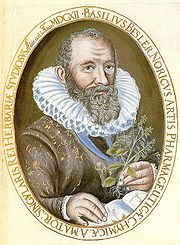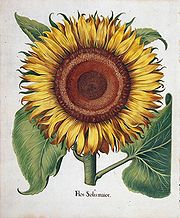
Basilius Besler
Encyclopedia

Nuremberg
Nuremberg[p] is a city in the German state of Bavaria, in the administrative region of Middle Franconia. Situated on the Pegnitz river and the Rhine–Main–Danube Canal, it is located about north of Munich and is Franconia's largest city. The population is 505,664...
apothecary and botanist, best known for his monumental Hortus Eystettensis. He was curator of the garden of Johann Konrad von Gemmingen, prince bishop of Eichstätt
Eichstätt
Eichstätt is a town in the federal state of Bavaria, Germany, and capital of the District of Eichstätt. It is located along the Altmühl River, at , and had a population of 13,078 in 2002. It is home to the Katholische Universität Eichstätt-Ingolstadt, the lone Catholic university in Germany. The...
in Bavaria
Bavaria
Bavaria, formally the Free State of Bavaria is a state of Germany, located in the southeast of Germany. With an area of , it is the largest state by area, forming almost 20% of the total land area of Germany...
. The bishop was an enthusiastic botanist who derived great pleasure from his garden, which was the only important European botanical garden outside Italy.
The gardens surrounded the bishop's palace, Willibaldsburg, which was built on a hill overlooking the town. These gardens had been started in 1596 and designed by Besler's colleague, Joachim Camerarius the Younger
Joachim Camerarius the Younger
Joachim Camerarius the Younger was a German physician, botanist, and humanist scholar.-Life:...
(1534-1598), a physician and botanist. Upon Camerarius' death in 1598, Besler had the remainder of Camerarius' plants moved to Eichstätt and carried on the work of planting and supervision. The bishop commissioned Besler to compile a codex of the plants growing in his garden, a task which Besler took sixteen years to complete, the bishop dying shortly before the work was published. Besler had the assistance of his brother and a group of skilled German draughtsmen and engravers, including Sebastian Schedel, an accomplished painter, and Wolfgang Kilian, a skilled engraver from Augsburg
Augsburg
Augsburg is a city in the south-west of Bavaria, Germany. It is a university town and home of the Regierungsbezirk Schwaben and the Bezirk Schwaben. Augsburg is an urban district and home to the institutions of the Landkreis Augsburg. It is, as of 2008, the third-largest city in Bavaria with a...
. Kilian and his team engraved the initial copper plates, but after the bishop’s death, the operations moved to Nürnberg and a new team of engravers, among whom were Johannes Leypold, Georg Gärtner, Levin and Friedrich van Hulsen, Peter Isselburg, Heinrich Ulrich, Dominicus Custos
Dominicus Custos
Dominicus Custos , was a Flemish artist, printer and copperplate engraver, who worked in the service of Emperor Rudolph II in Prague....
and Servatius Raeven. Camerarius' nephew, Ludwig Jungermann (1572-1653), was a botanist and wrote the lion's share of the descriptive text.

Italian coin florin
The Italian florin was a coin struck from 1252 to 1533 with no significant change in its design or metal content standard. It had 54 grains of nominally pure gold worth approximately 200 modern US Dollars...
, while the plain, uncoloured copies went for 35 florins each. Besler could finally purchase a comfortable home in a fashionable part of Nürnberg at a price of 2 500 florins – five coloured copies' worth of ‘Hortus Eystettensis'.
The work generally reflected the four seasons, showing first the flowering and then the fruiting stages. "Winter" was sparsely represented with a mere 7 plates. "Spring" was a season of abundance with 134 plates illustrating 454 plants and "Summer" in full swing showed 505 plants on 184 plates. "Autumn" closed off the work with 42 plates and 98 species. The modern French version of the herbal is known as the Herbier des quatres saisons, repeated in the 1998 Italian version L'erbario delle quattro stagioni.
Descriptions of the plants were in Latin and showed remarkable anticipation of the binomial system, in that the captions often consisted of the first two or three words of the description. Besler's portrait appears on the frontispiece holding a sprig of greenery, thought to be basil
Basil
Basil, or Sweet Basil, is a common name for the culinary herb Ocimum basilicum , of the family Lamiaceae , sometimes known as Saint Joseph's Wort in some English-speaking countries....
. The work was published twice more in Nuremberg in 1640 and 1713, using the same plates, plates which were destroyed by the Royal Mint of Munich in 1817.
The gardens were sacked by invading Swedish troops under Herzog Bernhard von Weimar in 1633-4, but were reconstructed and opened to the public of Eichstätt in 1998.

